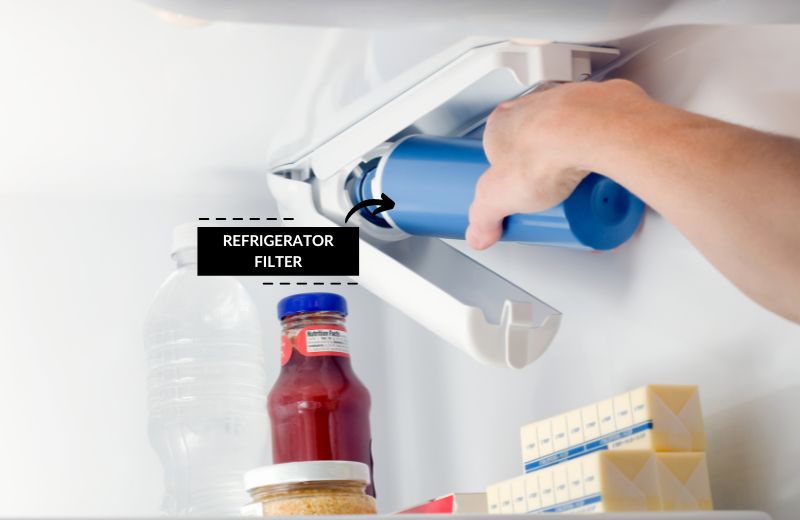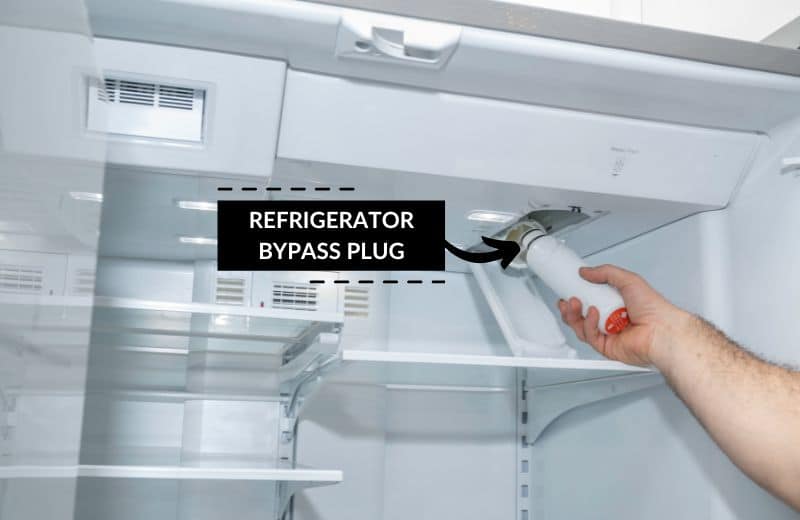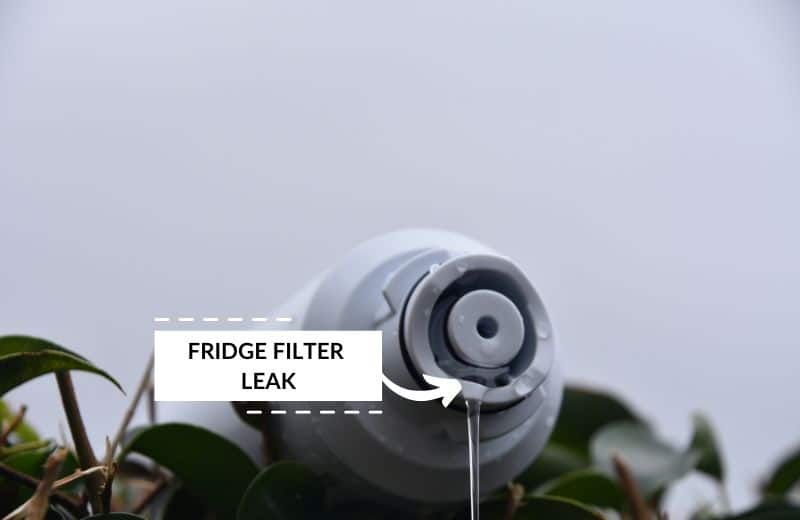Don’t want to use the water filter in your refrigerator? You can bypass the filter – sometimes without any effort – depending on the age and model of your fridge.
In this guide, we’ve shared the various methods to bypass a refrigerator water filter.
📌 Key Takeaways:
- There are three methods to bypass a fridge water filter, depending on the fridge model and the filter type.
- Either simply remove the filter, install a new bypass plug, or install a tube straight push connector in place of the filter.
- Most refrigerators have a filter lifespan of 6 months. Bypass the filter if you don’t want the hassle or expense of replacing the filters twice a year.
Table of Contents
📤 How to Bypass A Refrigerator Water Filter: 3 Methods
These three methods are the best ways to bypass your fridge water filter.
Method 1: Just Remove The Filter
Many modern refrigerators have an automatic bypass function that means you don’t have to do or buy anything to bypass the water.
Simply remove the filter and the refrigerator will detect the empty filter housing and automatically divert water around the housing.
If you’re not sure whether your refrigerator has an automatic bypass, try removing the filter and pressing the water dispenser or ice maker button. If you can’t dispense water or ice, your filter doesn’t have an automatic bypass, and you’ll need to move on to one of the methods below.

Method 2 (For Built-In Fridge Filters): Install A Bypass Plug
If you have a push-in or screw-in filter inside your fridge, you should be able to bypass water through or around the filter housing by installing a refrigerator filter bypass plug.
There are several types of filter bypass plugs, including plug-shaped devices, caps, and cartridge-shaped devices.
To install a refrigerator bypass plug in place of your water filter, follow these steps:
- Locate your filter. Most refrigerator water filters are found in the top left or right-hand corners, between the crisper drawers, or built into the fridge door. Your filter might also be located in the base grille at the back of the fridge.
- Remove the existing filter. You can do this by pulling and twisting the filter head, or pushing the release button to trigger the filter to pop out. Put it to the side for now. You can recycle it later on.
- Install the refrigerator filter bypass plug in place of the water filter. To do this, follow the same steps for installing the filter. You might need to turn the bypass plug in a clockwise direction, or push the bypass into the filter housing until you hear a click.
- Dispense water or ice. Try out your ice maker or water dispenser. If you’re able to dispense water or ice, the water filter bypass system is working.
- Check for leaks. If no leaks are detected, you’ve correctly installed the bypass.

Method 3 (For Inline Fridge Filters): Install A Tube Straight Push Connector
It takes a bit of extra effort to bypass inline fridge water filters because you can’t simply use a bypass plug for these filters.
To bypass an inline refrigerator filter, here’s what to do:
- Gather your materials. You’ll need a 1/4 inch to 1/4 inch tube straight push connector. If there isn’t a lot of slack at the install location, you might also need extra 1/4 inch tubing.
- Cut each side of the existing tubing attaching the old filter to your fridge water line. Remove the old filter and leave it aside.
- Attach the tube straight push connector to the water line, pushing each of the tubes into each end. You should hear a click when the tubes are connected.
- Test your ice maker or water dispenser. If they work, you’ve successfully installed the bypass.
🤔 Why Bypass A Refrigerator Water Filter?
You might want to bypass your fridge’s water filter if:
- You don’t want the hassle of buying replacement filters every 6 months.
- Your filter is leaking, and you want to send water around the filter until you can solve the problem.
- You already have an inline water filter or an under-sink water filtration system that filters your water before it reaches the fridge.
- You need to replace the filter, but you haven’t bought a new one yet.
- You don’t care about drinking cleaner, fresher water from your fridge’s water dispenser.
- You never use the water dispenser or ice maker, so there’s no use for the water filter.
Whatever your situation, if you don’t want to use a water filter in your fridge, we strongly recommend removing the filter and (if necessary) installing a filter bypass.
If you simply leave the filter in your fridge beyond its anticipated lifespan, you put yourself at risk of drinking water that might contain bacteria and other contaminants that have leaked back into your water from the degraded filter media.
It’s always better to use no water filter at all than to drink water that has come into contact with a very old filter.

⚖️ Pros & Cons of Bypassing a Fridge Water Filter
There are a few benefits and setbacks of installing a water filter bypass in your refrigerator:
Pros
- You won’t have to worry about filter changes.
- No new water filters = no added expense.
- There’s no risk of forgetting to replace the filter – and potentially getting sick due to bacteria buildup in the filter.
- You can still dispense ice and water from the fridge because the filter bypass will simply send water around the filter housing.
Cons
- If you don’t have any other water filtration system installed, your fridge’s water dispensers and ice makers will dispense normal tap water.
- Normal water from your tap isn’t as clean as, and tastes nowhere near as nice, as filtered water.
- You’ll drink more chlorine, disinfection byproducts, and trace mineral deposits as a result of removing the fridge filter.
Related Content:
- The best refrigerator water filters money can buy
- How well do refrigerator water filters work?
- Step-by-step process for connecting your fridge filter to an RO system
❔ How to Bypass A Refrigerator Water Filter: FAQ
Do I need to shut off my water supply to bypass a fridge filter?
No, in most cases, you won’t need to shut off your water supply while you’re replacing your refrigerator’s water filter with a bypass plug. Usually, the water flow will automatically shut off, so you shouldn’t get any leaks. The only exception is if you’re replacing an inline water filter behind the fridge. Then, you should shut off the water leading to the fridge from your kitchen sink.
Can you bypass the water filter on a Samsung refrigerator?
Yes, you can bypass the water on a Samsung refrigerator. Most modern Samsung models have water filter housings that act as rotary valves, meaning that water bypasses the housings when there’s no filter installed. There’s no need to cover the housing opening with the included cap, which is shipped with the fridge to prevent debris from getting into the housing before the filter is installed.
Can I use my Whirlpool refrigerator without the water filter?
Yes, you can use a Whirlpool refrigerator without the water filter. Modern Whirlpool refrigerators have an automatic bypass system that diverts water away from the fridge’s water filter housing when it detects the filter isn’t installed.
How to bypass refrigerator water filter Kitchenaid?
To bypass a Kitchenaid water filter, you’ll need to buy the Kitchenaid water filter bypass plug. Simply screw the plug onto the filter housing to prevent water from flowing through the filter.
Can you drink water from a refrigerator without a filter?
Yes, you can drink the water from a refrigerator without a filter. All it means is that you’ll be drinking normal tap water rather than filtered water. Using a filter in your fridge is always best because it improves water’s taste and health properties, but drinking normal tap water is safe if you have a city water supplier.
